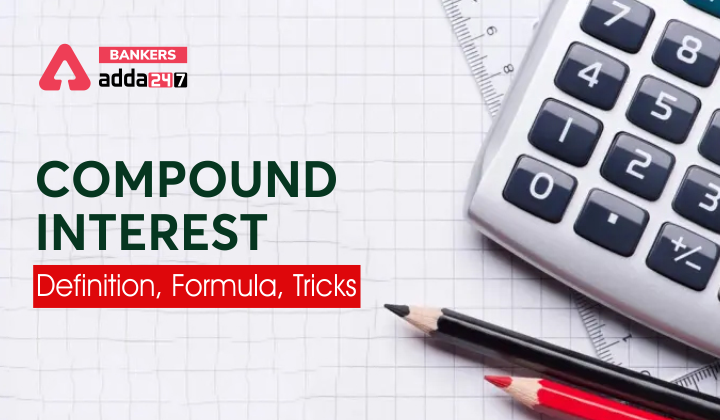Table of Contents
Compound Interest: Compound Interest is one of the most scoring and important topics in the quantitative aptitude section. Compound Interest is usually asked in the set of 1 to 2 questions so, to excel in these topics aspirants will need to know how to solve them. To help the aspirants in solving puzzle questions, in this article, we have provided all the necessary details related to Compound Interest like the definition of compound interest, tips, tricks, concepts, questions, answers, explanations, etc.
Definition Of Compound Interest
Compound Interest occurs when interest gets added to the principal amount invested or borrowed, and then the interest rate applies to the new principal. Compound Interest can be thought of as “interest on Interest”. It will make a sum grow at a faster rate than simple interest, which is calculated on the principal amount. It is the interest on a loan or deposit calculated based on both the initial principal and the accumulated interest from previous periods.
How to Calculate Compound Interest
Candidates can calculate compound interest with a simple formula. It is calculated by multiplying the first principal amount by one and adding the annual interest rate raised to the number of compound periods subtract one.
The compound interest formula is:
A = P (1+r/n)nt

A= Amount
P= Principal Amount
N= Period of time
R= Rate of Interest
T= Time
Compound Interest: Definition, Formula & How To Calculate With Short Trick in Hindi
Compound Interest Tips, Tricks, & Concepts
- The interest calculated on the initial principal is called Compound interest and it includes all of the accumulated interest from previous periods on a deposit or loan.
- Interest can be compounded on any given frequency schedule, from continuous to daily monthly, or annually.
- When we are calculating compound interest, the number of compounding periods makes a significant difference.
- To Calculate the compound interest we multiply the initial principal amount by one plus the annual interest rate raised to the number of compound periods minus one.
Compound Interest Questions, Answers, & Explanation
Q1. A man invested a sum in a scheme ‘P’ which offer 10% C.I.P.A. for 3 years and earn Rs. 1655. Find the interest earned by a man, if he invested the total amount he gets from scheme ‘P’, in scheme Q which offers 8% S.I.P.A for 5 years.
(a) Rs.4317
(b) Rs.1655
(c) Rs.1331
(d) Rs.2662
(e) Rs.2000
Solution:
Q2. A sum becomes Rs. 4840 in two years and Rs. 5856.4 in four years when compounded annually. What would be the amount if the same sum was invested at 15% S.I. for 3 years (in Rs.)?
(a) 5600
(b) 5000
(c) 6400
(d) 6200
(e) 5800
Q3. The difference of the interest received when a sum is invested at 15% p.a. at SI for two years and the interest received when that sum is invested at 20% p.a. for one year compounded half yearly is Rs 432, find the sum?
(a) Rs. 5400
(b) Rs. 5000
(c) Rs. 4500
(d) Rs. 4000
(e) Rs. 4800
Q4. If Sonu invests a sum at compound interest compounding annually and earns Rs. 372 in the second year. Find the amount he invested (in Rs.)?
(a) 3377
(b) 2211
(c) 3300
(d) 3784
(e) 3751
Q5. Veer, Sameer, and Neeraj invested their amount on simple interest in the ratio of 4: 5: 8 respectively. The rate of interest for Veer, Sameer, and Neeraj is 12.5%, 10%, and 20% respectively. After two years of investment Veer, Sameer and Neeraj joined a business with the amount obtained from interest only for 12 months, 18 months, and 15 months respectively. If the total profit from the business is Rs 8450, then find the difference between the profit shares of Neeraj and Sameer?
(a) 3625 Rs.
(b) 3650 Rs.
(c) 3850 Rs.
(d) 3750 Rs.
(e) 3250 Rs.
Q6. Aman divided his total saving between his son and daughter in the ratio of 5 :3. His son invested his share on CI for two years at the rate of 10% and received the interest Rs. 480 less than his sister, who invested her share on SI for three years at the rate of 15%. Find Share of Aman’s son and daughter respectively?
(a) 10800 Rs, 2000 Rs
(b) 9600 Rs, 4200 Rs
(c) 8000 Rs, 4800Rs.
(d) 9800 Rs, 3000 Rs
(e) 7000 Rs , 5800 Rs
Q7. An amount is invested at S.I. for three years at a rate of 5% and S.I. received on that amount is Rs. 180. If the same amount is invested for two years at 10% C.I. for the first year & R% C.I. for 2nd year & the total C.I. received in two years is Rs. 318 then find the value of R?
(a) 15%
(b) 12%
(c) 22%
(d) 18%
(e) 25%
Q8. A lent B Rs.12000 on C.I. at the rate of 20% per annum and at the end of the first year B borrowed Rs. ‘x’ more from A on C.I. at the same rate. If at the end of the second year, B paid a total amount of Rs.20400 to A, then find the value of x?
(a) Rs.2400
(b) Rs.2000
(c) Rs.3600
(d) Rs.2600
(e) Rs.4000
Q9. A sum becomes Rs 6888 in 8 years and becomes Rs 7380 in 10 years at the same rate on simple interest. Find compound interest earned in 3 years on Rs 4000 at same rate of interest.
(a) Rs 630.5
(b) Rs 1261
(c) Rs 784.5
(d) Rs 1008
(e) Rs 1080
Q10. Satish invested Rs. 14,000 partially in scheme A which offer 20% p.a. at C.I. and remaining in scheme B which offers 25% at S.I. Find the amount invested in scheme B if total interest earns after 2 years is Rs. 6640.
(a) 6000
(b) 7000
(c) 8000
(d) 9000
(e) 10,000
Q11. Deepak invested some amount on SI out of Rs.47000 and rest amount on C.I. for two years. If S.I. is offering 12% p.a. and C. I. is offering 15% p.a. compounding annually and C.I. is Rs.532.5 more than S.I., then find amount invested by Deepak on C.I?
(a) Rs.23000
(b) Rs.22000
(c) Rs.21000
(d) Rs.25000
(e) Rs.24000
Q12. Aman spends 18,000 partially in scheme ‘A’ which offers 15% pa at C.I. and remaining in scheme ‘B’ which offers 25% p.a. at C.I. After 2 year he earns Rs. 7725 as interest. Find amount invested on scheme ‘B’ is what percent less or more than the amount invested on scheme ‘A’.
(a) 25%
(b) 20%
(c) 15%
(d) 50%
(e) 30%
Q13. If the difference between S.I on Rs. 2000 and C.I on 1600 for two year at the same rate of interest is Rs. 64. Find the rate of interest. (S.I > C.I)
(a) 5%
(b) 10%
(c) 20%
(d) 8.5%
(e) 12.5%
Q14. Arun invested Rs. 10,000 for three years at CI at the rate of 20% per annum. If in 1st and 3rd-year interest is calculated annually and in 2nd year it was calculated half-yearly, then find the total interest received by Arun in three years?
(a) Rs 7554
(b) Rs 7424
(c) Rs 7868
(d) Rs 7262
(e) Rs 7343
Q15. The difference between CI received in the first 1.5 years (compounded annually) at 20% per annum and CI received in last 1.5 years when compounded half yearly at the same rate of interest on the same sum is Rs 715 then find the sum?
(a) Rs. 66,000
(b) Rs. 65,000
(c) Rs. 64,500
(d) Rs. 65,500
(e) Rs. 67,500
Latest Govt Jobs Notifications
FAQs: Compound Interest
Q1. What is Compound Interest?
Ans. Compound Interest occurs when interest gets added to the principal amount invested or borrowed, and then the interest rate applies to the new principal. Compound Interest can be thought of as “interest on Interest”.
Q2. In which examination Compound Interest Questions are asked?
Ans. Compound Interest Questions are asked in various competitive exams like IBPS PO, SSC GCL, MTS, Railways, SBI PO, SO Clerk, RRB PO, Clerk, SO, LIC AAO, ADO, Assistant, etc.
Q2. How to calculate Compound Interest?
Ans. Candidates can check short tricks and tips to calculate Compound Interest in the given above article.
Current Affairs
| Current Affairs April 2022 | |




 GA Capsule for SBI Clerk Mains 2025, Dow...
GA Capsule for SBI Clerk Mains 2025, Dow...
 The Hindu Review October 2022: Download ...
The Hindu Review October 2022: Download ...
 Reading Comprehension Questions for SBI ...
Reading Comprehension Questions for SBI ...


